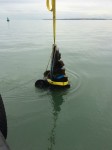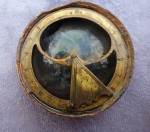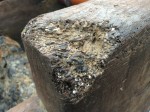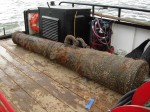 Archaeologists have successfully recovered an intact wooden gun carriage in excellent condition from the wreck of the 17th century warship the London in the Thames estuary. The gun carriage, sized to hold a cannon nine feet long, is the only complete one of its kind from this period known to survive.
Archaeologists have successfully recovered an intact wooden gun carriage in excellent condition from the wreck of the 17th century warship the London in the Thames estuary. The gun carriage, sized to hold a cannon nine feet long, is the only complete one of its kind from this period known to survive.
Alison James, a Historic England maritime archaeologist, said: “This 350 year old gun carriage is in near-perfect condition. It’s a national treasure and the key to new knowledge of our social and naval history. We had to recover it quickly or it would have broken up and been lost forever.
“It’s complete with all the implements that the gunner would have used to make the cannon fire — all the archaeological material is there with it so it’s hugely exciting. Until now, it’s been well preserved, enclosed in an anaerobic environment, oxygen-free mud, safe from all the creepy-crawlies that would normally erode it. We’ve even got the 350 year old rope going through the pulley block. But as parts of the gun carriage recently became exposed, we had to act fast to save this rare piece of our history from the ravages of the waves and biological attack,” she said.
The London was one of three Second Rate ships of the line built in 1656 during the Commonwealth by command of Lord Protector Oliver Cromwell. (That’s why there’s no HMS in front of it, because there was no HM when it was built.) Larger, updated versions of the Jacobean Great Ship, the Second Rates would have been a formidable addition to the Commonwealth Navy, but while the order was for 10 ships, only three were completed, and only the London survives in any form at all. The other two burned to ashes before the century was out. Cromwell must have rolled over in his soon-to-be-unquiet grave when the London was part of the fleet that brought the restored King Charles II back to England from the Netherlands. It carried the king’s brother, the Duke of York, the future King James II of England.
 Just five years after the restoration of the monarchy, the London met a sudden explosive end. Freshly outfitted for action in the second Anglo-Dutch War, the London was sailing from the shipyard in Chatham to the Hope where it would pick up its commander Sir John Lawson and meet destiny as flagship of the Red Squadron. Just before reaching its destination, the London suddenly blew up. We don’t know the exact cause of the explosion. Historians believe that the crew was preparing a 17-gun salute to welcome their commander when something went horribly wrong and the 300 barrels of gunpowder on board ignited blowing the ship in two.
Just five years after the restoration of the monarchy, the London met a sudden explosive end. Freshly outfitted for action in the second Anglo-Dutch War, the London was sailing from the shipyard in Chatham to the Hope where it would pick up its commander Sir John Lawson and meet destiny as flagship of the Red Squadron. Just before reaching its destination, the London suddenly blew up. We don’t know the exact cause of the explosion. Historians believe that the crew was preparing a 17-gun salute to welcome their commander when something went horribly wrong and the 300 barrels of gunpowder on board ignited blowing the ship in two.
Diarist Samuel Pepys recorded the event with sorrow in his March 8th entry.
This morning is brought me to the office the sad newes of “The London,” in which Sir J. Lawson’s men were all bringing her from Chatham to the Hope, and thence he was to go to sea in her; but a little a’this side the buoy of the Nower [a Thames Estuary sandbank], she suddenly blew up. About 24 [men] and a woman that were in the round-house and coach saved; the rest, being above 300, drowned: the ship breaking all in pieces, with 80 pieces of brass ordnance. She lies sunk, with her round-house above water. Sir J. Lawson hath a great loss in this of so many good chosen men, and many relations among them.
There were men, women and children on board who were not part of the crew; they were guests attending the launch, including much of Lawson’s extended family. Pepys’ estimate that there were 300 people on the London could be extremely low, therefore. There could have been as many as 500 on board, and only 25 survived.
 The wreck of the London was rediscovered in 2005 during an archaeological survey in advance of the London Gateway Port development on the north bank of the Thames in Thurrock, Essex. Three years later it was designated a Protected Wreck Site and English Heritage (now renamed Historic England) contracted Wessex Archaeology to explore and document the wreck. The Port of London Authority moved the shipping channel to keep from disturbing the wreck, but it wasn’t enough. Starting in 2010, expert Thames Estuary diver Steven Ellis, who was licensed by the government to dive the wreck, and volunteers under his guidance monitored the London regularly. They found that erosion and movement of the sediment around the wreck were making the ship unstable and artifacts were being dislodged and lost in the murky waters.
The wreck of the London was rediscovered in 2005 during an archaeological survey in advance of the London Gateway Port development on the north bank of the Thames in Thurrock, Essex. Three years later it was designated a Protected Wreck Site and English Heritage (now renamed Historic England) contracted Wessex Archaeology to explore and document the wreck. The Port of London Authority moved the shipping channel to keep from disturbing the wreck, but it wasn’t enough. Starting in 2010, expert Thames Estuary diver Steven Ellis, who was licensed by the government to dive the wreck, and volunteers under his guidance monitored the London regularly. They found that erosion and movement of the sediment around the wreck were making the ship unstable and artifacts were being dislodged and lost in the murky waters.
 An initial project of artifact recovery began in 2012 and last year Historic England received funding for a two-year evaluation of the site that would ensure the recovery of archaeological remains deemed in danger of loss, damage or destruction, study the structure of the wreck and determine how best to keep the London safe from environmental threats like erosion, the warming ocean and woodworm. The team includes experienced divers like Steve and Carol Ellis and professional maritime archaeologists from contractors Cotswold Archaeology. Ellis’ team found the gun carriage exposed on the seabed last year. After eight months They determined the gun carriage was in immediate danger from woodworm and decided to raised it.
An initial project of artifact recovery began in 2012 and last year Historic England received funding for a two-year evaluation of the site that would ensure the recovery of archaeological remains deemed in danger of loss, damage or destruction, study the structure of the wreck and determine how best to keep the London safe from environmental threats like erosion, the warming ocean and woodworm. The team includes experienced divers like Steve and Carol Ellis and professional maritime archaeologists from contractors Cotswold Archaeology. Ellis’ team found the gun carriage exposed on the seabed last year. After eight months They determined the gun carriage was in immediate danger from woodworm and decided to raised it.
 As for the cannon that used to ride that carriage, it may still be below or may have been recovered. Five bronze cannons have been retrieved from the site since its rediscovery in 2005. Three of them are Dutch weapons that were taken from ships captured during the first Anglo-Dutch War in 1653 and then loaded onto the London. Two of them are English, one bearing the coat-of-arms of the Commonwealth weapons, one an extremely rare piece made in 1590 by London royal gun founder Peter Gill, and are now housed at the Royal Armouries in Portsmouth. The three Dutch cannons were illegally sold to a private collector in Florida by an unscrupulous diver/looter who lied about finding them in international waters. Since carriages were custom-made to fit a specific gun, if it held one of the five known cannons on the London, experts might be able to match them up. It’s a long shot, if you’ll pardon the pun, because the London was fitted with 76 guns. Nine were salvaged before 1700, their whereabouts now unknown. That means there could be as many as 62 of the ship’s cannons still embedded in the silt of the Thames Estuary, or they could have been destroyed in the explosion, dragged elsewhere by the currents or, sadly, looted.
As for the cannon that used to ride that carriage, it may still be below or may have been recovered. Five bronze cannons have been retrieved from the site since its rediscovery in 2005. Three of them are Dutch weapons that were taken from ships captured during the first Anglo-Dutch War in 1653 and then loaded onto the London. Two of them are English, one bearing the coat-of-arms of the Commonwealth weapons, one an extremely rare piece made in 1590 by London royal gun founder Peter Gill, and are now housed at the Royal Armouries in Portsmouth. The three Dutch cannons were illegally sold to a private collector in Florida by an unscrupulous diver/looter who lied about finding them in international waters. Since carriages were custom-made to fit a specific gun, if it held one of the five known cannons on the London, experts might be able to match them up. It’s a long shot, if you’ll pardon the pun, because the London was fitted with 76 guns. Nine were salvaged before 1700, their whereabouts now unknown. That means there could be as many as 62 of the ship’s cannons still embedded in the silt of the Thames Estuary, or they could have been destroyed in the explosion, dragged elsewhere by the currents or, sadly, looted.
The gun carriage will be conserved in York, a process that could take years, before going on display at Southend-on-Sea Borough Council’s Museums Service.